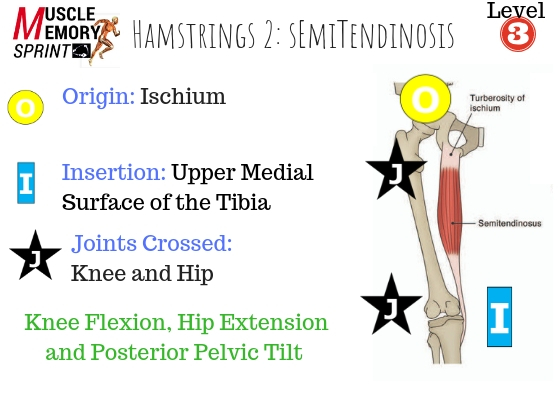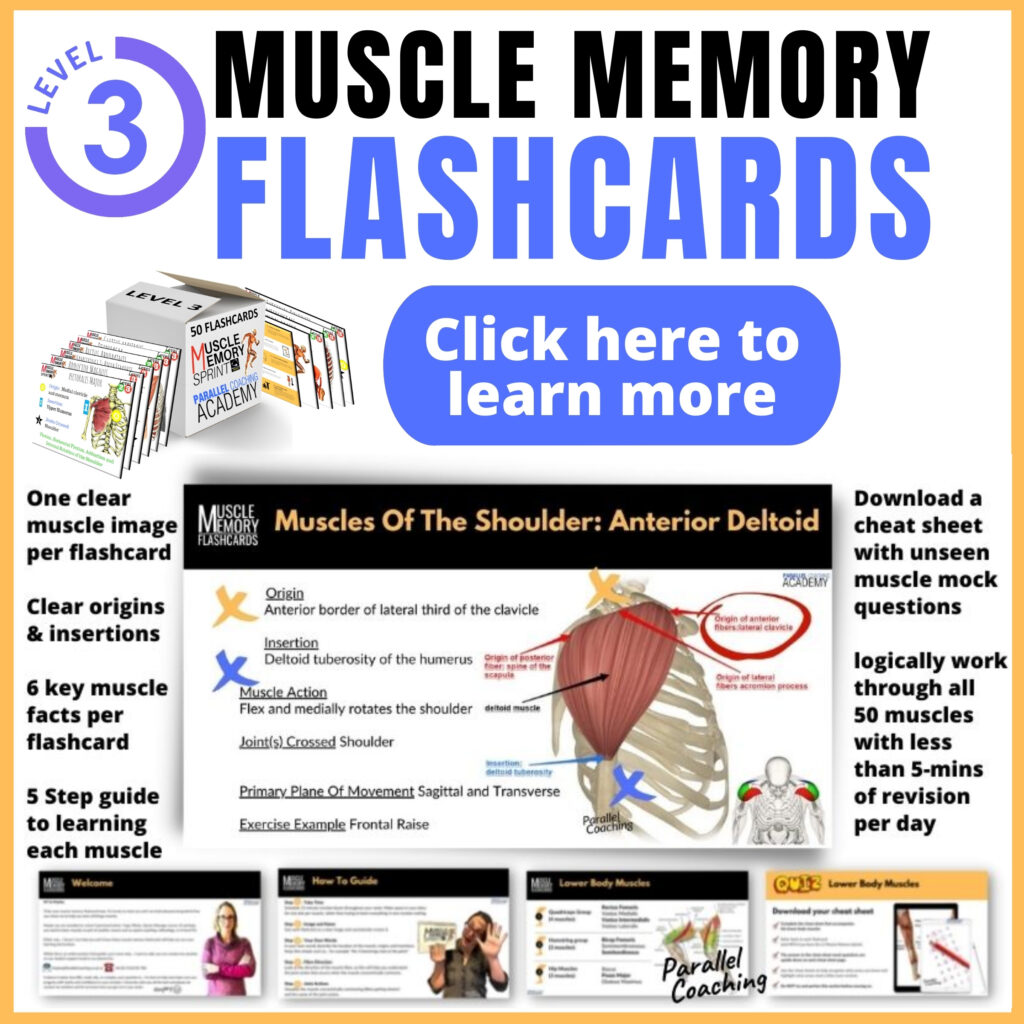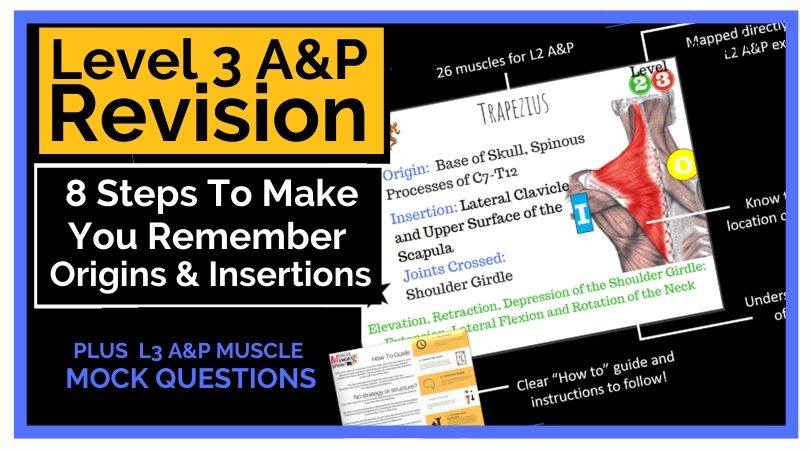This blog will teach 8 steps to make you remember origins and insertions and pass your anatomy exam the first time
You’ll discover:
- Why is learning muscles so overwhelming?
- A clear 8-step guide to remembering Origins and Insertions
- How many questions you will have in your exam
- When should I do the 8 steps?
- How to simplify your muscle memory learning plan
- Three Example Mock Questions about Origins and Insertions
Why is learning muscles so overwhelming?
Most trainee FitPros hate learning the muscles and origins and insertions in preparation for your Level 3 anatomy and physiology exam.
I’m convinced that this hate for learning is not a reflection of the topic (muscles) but a reflection of HOW you are revising.
One look at the endless table of muscles in your Level 3 anatomy manual, can make your heart sink, your brain flip in circles and your gut feel horrendous…
It’s daunting and overwhelming
But as with any big project, the easiest way to face something that is daunting
… is… (drum roll)…
break it down into little chunks!
That’s what we do here with our 8 step guide
8 steps to make you remember origins and insertions
1) THE BIG PLAN
Work out how many muscles you need to know for your exam. This is usually 50 at level 3 and 26 at level 2 but can vary depending on your course.
Make sure you get a clear list of all of those you need to learn
2) DIARISE
Create diary slots of 15 minutes that spread between now and your exam. If you have to learn 50 muscles, then you will need 50 revision slots;
3) LOOK AT A CLEAR IMAGE
When you start your 15-minute muscle study session, you’ll need a clear image of the muscle.
If you can’t find a decent image of the muscle with labels? Check out our Muscle Memory Flashcards HERE
For today’s challenge use this flashcard to learn the Semitendinosis, one of the hamstring muscles:

Look at the picture of the muscle and burn it into your retina.
Not literally, but really look at it, for a good few minutes
Look for key features of the muscle:
- where is it on the body (in your words) ?
- what shape is the muscle?
- is it big or small?
- Is there anything distinctive about it?
Close your eyes and try to remember the image
4) NAME IT
If you’ve got the mental image fixed in your mind, now add the name of the muscle to it and burn that into your memory, so when you close your eyes, you see the muscle and its name of it.
Add the name of the muscle to your mental image
5) REMEMBER ORIGINS AND INSERTIONS
Now in your own words, consider where the muscle starts and finishes, how does it attach to the skeleton?
Indicate where on the image the origin and insertion would be.
Now look at it, and commit it to memory.
If when you close your eyes you cannot see all of the detail, then try this a few more times, looking at the image and then closing your eyes.
6) BELIEVE IT
Once it is committed to memory, you need to believe that you know it, so test yourself once more and tell yourself you know it 🙂
7) GET MOVING
To Seal the deal, do an action that uses that muscle, and imagine the image in your head at the same time.
You can touch the muscle, touch the approximate origin and insertion, and feel the muscle shorten and lengthen as you move.
8) RELAX
This step is really important for avoiding being overwhelmed and fatigue.
Take some time out from learning muscles, go onto another part of revision or do something totally different
When should I do the 8 steps?
This is a great task to do on the train if you commute, or on your lunch break (as long as you can get some peace and quiet), or before your morning shower, or even partway through the day whilst the kettle boils.
It will literally take 15 minutes per muscle.
Once you have gradually done all of the muscles you need to know, then go back and summarise/ revise and test yourself, you’ll be surprised what you remember
If you want to use the 8 steps but without the faff of finding images and adding text, then I have a tool for you that will make it super simple.
Check out our Muscle Memory Sprint including the 50 muscle flashcards HERE.
In summary
- You need to learn 26 muscles at level 2 and 50 at level 3 anatomy
- Breaking up your muscle learning into 15-minute chunks will help avoid overwhelm and revision fatigue
- Use these 8 steps to remember the origins and insertions
- Simplify your muscle memory revision with our Muscle Memory sprint
- Here’s what Lydia had to say about the Muscle Memory Flashcards👇 👇 👇
I can’t recommend Parallel Coaching enough their learning material is fantastic and definitely was a huge factor in me passing my A&P level 3
Lydia Farrant
Test your knowledge with today’s mock questions:
[NOTE: The answers are below the 3rd questions]
1: What is the origin of the Semitendinosus Muscle
A. Ilium
B. Ischium
C. Femur
D. Tibia
2: What is the Insertion of the semitendinosus muscle?
A. Ilium
B. Fibula
C. Tibia
D. Femur
3: What joint action occurs when the hamstring contracts eccentrically?
A. Knee extension
B. Knee Flexion
C. Hip Internal Rotation
D. Hip Extension
What’s the CORRECT answer?
Answers:
Question 1= B, Question 2 = C, Question 3 = A
If you want more mock questions like this, then you can download more Free Mock Questions: DOWNLOAD NOW
How to learn origins and insertions?
Learn, Revise & Remember All 50 Muscles In The Level 3 Anatomy & Physiology Exam.
(and the BEST part…You can do all this in as little as 5-minutes a day)
Each flashcard gives you a clear image and six clear muscle facts:
- Name and Location
- Origin and Insertions
- Muscle Actions
- Joints Crossed
- Primary Planes Of Movement
- Exercise Examples
https://courses.parallelcoaching.co.uk/products/level-3-muscle-memory-flashcards/

Dedicated to More
Hayley “8 steps to make you remember origins and insertions” Bergman
Parallel Coaching
P.S. You can also find us on the following platforms:
Instagram: Follow Now
Facebook: Like Our Page
Twitter: Tweet Us
YouTube: Subscribe Here
More Muscle Revision Blogs: HERE


I’m going to take the MBLEX in June/July.
How can I purchase the Muscke Memory Flash Cards?
Thank you
Linda
Pingback: My Homepage